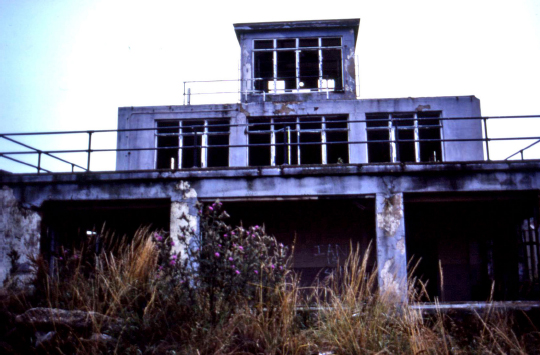
From its beginning in World War I, the true bomber was designed to carry and deliver bombs in level flight against specific targets at medium to long range. Combatants who were utilizing airships for this purpose soon discovered their vulnerability to both ground fire and air attack by the scout planes of the day. They quickly shifted to the use of two-seat craft like the BE 2e, operated from the summer of 1916 by the Royal Flying Corps. It arrived in time for the Battle of the Somme, but left much to be desired as a bomber. Cruising at little more than sixty miles per hour at only a few thousand feet of altitude, this flimsy craft was also prey to ground fire and its marginal performance was seriously reduced through having to carry the added weight of bombs. When sent to attack a target, and carrying a maximum bomb load, the observer had to be left back at the base.
Probably the earliest recorded concept of aerial bombing comes from the Hindu epic poem, the Mahabharata of Krishna-Dwaipayana-Vyasa. In it is a description of the enemies of Krishna inducing demons to construct a winged chariot to be driven through the sky until it stood over Dwarakha, home of the followers of Krishna. From it missiles would be thrown down upon the city, destroying everything on which they fell.
In 1670 the Italian Jesuit Francesco Lana de Terzi designed an “aerial ship” which was to be borne aloft by four copper globes from which the air had been evacuated. He is said to have allowed, though, that “God might prevent its construction since such a device might descend on an enemy’s fleet, kill their men and burn their ships by artificial fireworks and fireballs. And this they may do not only to ships but to great buildings, castles and cities, with such severity that they which cast these things down from a height out of gun-shot, cannot on the other side be offended by those from below.”

The Flying Control tower at RAF Bovingdon;
It was in 1793 that aeronautic inventor Joseph-Michel de Montgolfier proposed that his balloon might be used to drop two large bombs on the port of Toulon, France, which was then rebelling against the Republican government. It didn’t happen. But in 1849, Austrians laying siege to Venice became the first combatants to drop bombs on their enemy. In fact, while the Germans, French, and British dithered over the concept of aerial bombardment by balloon, the Austrians had already established several balloon battalions using the balloons of Montgolfier, which were capable of lifting thirty-three pounds of bombs and staying aloft for more than half an hour. The Austrians utilized trial balloons for testing the strength and direction of the wind before successfully flinging some of their bombs on Venice, whose residents’ morale suffered more than their property.

The remains of the bomb dump at Grafton Underwood, wartime home of the 384th Bomb Group.
An engine of the B-17 Sally B at Duxford, Cambridgeshire.
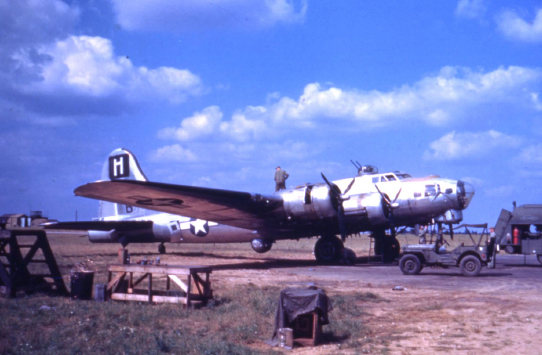
A B-17G of the 388th Bomb Group at Knettishall, England;
Eighth Air Force gunners preparing their weapons for installation at their positions in this B-17 bomber.
Among the earliest proponents of aerial bombing from balloons was Henry Tracey Coxwell who, in the mid-1800s wrote: “I have no doubt that it would be possible to drop, with tolerable nicety, a host of aerial vessels charged with agents calculated to produce stupefaction, if not fatal effects. If by this method our warriors could secure prisoners instead of increasing carnage, humanity would rejoice at so desirable a consumation by such ingenious means.” Balloons then, however, had certain drawbacks. They could only carry a relatively light bomb load, were at the mercy of the winds and were difficult to maneuver and their ordnance could not be delivered with accuracy. They were, in fact, really only a terror weapon for their time. This changed to some extent with the coming of the steerable rigid airships like the great Zeppelins at the beginning of the twentieth century. By 1910 Zeppelins had become capable of carrying a substantial bomb load over a considerable distance and were quite maneuverable.
In 1903 the brothers Orville and Wilbur Wright demonstrated their heavier-than-air flying machine at Kittyhawk in North Carolina, and in 1911 a Wright biplane was tested as a potential bombing aircraft by the U.S. Army. In that year the first actual use of airplanes to drop bombs took place in North Africa when an Italian expeditionary force utilized six Blériot aircraft to drop a total of four ten-kilogram hand grenade “bombs” on Turkish positions.
In Britain during 1912, the Royal Flying Corps was formed and soon began to develop offensive plans for aerial warfare, including the attacking of troop concentrations, supply centers, and ammunition dumps, as well as facilities for communications. The naval wing of the RFC split off from the parent organization in July 1914 and became the Royal Naval Air Service, which was then headed by the First Lord of the Admiralty, Winston S. Churchill. He made it the mission of the RNAS to seek and destroy the enemy, and took the lead in developing bombing and aerial torpedo operations, relying mainly on aircraft from private companies like Sopwith and Shorts rather than Government-sponsored planes from the Royal Aircraft Establishment, Farnborough. Prior to this, in 1913, Churchill had written about the German airships: “The Zeppelin should be attacked . . . by an aeroplane descending on it obliquely from above and discharging a series of bombs or fireballs, at rapid intervals, so that a string of them more than a hundred yards in length, would be drawn like a whip-lash across the gas bag.”
From the start of World War I the idea of aerial bombing was still suspect in most quarters and few military men believed that aircraft at that stage could even be useful in a reconnaissance role, much less as bombers. The only possible threat they could perceive was that of being bombed by the Zeppelins, and even that was offset to an extent by the difficulties facing the airship crews in crossing and navigating the great distance to England and locating worthwhile targets. Among the warring nations there was, in fact, little if any real priority given then to the development of bomber aircraft. The British War Office, for example, was interested in only three types of aircraft: a light single-seat scout; a two-seat reconnaissance machine; and a heavier two-seat fighter. While employed in a token bombing role through the occasional lobbing of grenades or “bomblets,” all of these aircraft were relatively underpowered and incapable of lifting more than a tiny bomb load. Thus, when the war came the Royal Flying Corps was operating aircraft with no real aerial bombing capability.
Initially, airmen of the various warring nations tried out the aerial bombing concept by dropping grenades. Some filled and dropped gasoline canisters and, in an interesting approach to anti-personnel bombardment, the French tried the dropping of fléchettes (steel darts) on the German cavalry units.
In the first true bombing attack of the war, the Germans sent the Zeppelin Z.VI to drop thirteen bombs on a fort defending Liege. The fort was untouched but nine civilians were killed in the raid. Ground fire damaged the airship which crashed on its return to Cologne. Various nuisance raids by individual scout aircraft of both sides followed and, within a month of the war’s opening shot, it was the Royal Naval Air Service that conducted the war’s first real bombing offensive. RNAS Sopwith biplanes based in Antwerp were modified to carry crude bomb racks and on 22 September 1914, four of the planes took off to attack the Zeppelin sheds at Cologne and Düsseldorf. Navigation and weather problems caused the raid to fail, but another strike by the Sopwiths two weeks later yielded significant results when one of the pilots located the main Düsseldorf Zeppelin shed. He dropped two twenty-pound bombs on the shed and managed to set aflame the new Z.IX Zeppelin inside. The airship was destroyed as were three additional Zeppelins during this period. Then, in November, three specially-equipped Avro 504s flew from a field near the French frontier to hit the Zeppelin works at Friedrichshafen. Through clever planning and execution, the Avros surprised the Germans and damaged a Zeppelin then under construction. They further damaged the airship works and the local gasworks was destroyed as well.
Now the miniscule bombing capability of existing aircraft, and the extreme vulnerability of the airships, led visionary planners of several nations to conclude that development of dedicated bomber aircraft was important, even essential. They further realized that they had to differentiate between bomber aircraft to be developed for tactical purposes and those meant for strategic attack. Tactical requirements were evident by the end of 1914 when both sides in the conflict were firmly dug in and stalled from the Channel coast all across France. Targets such as ammunition and supply storage, communications centers and troop concentrations were ripe for attack and were hit by the reconnaissance planes of the day operating in a dual capacity as bombers. Between early March and late June of 1915, some 141 tactical bombing raids were launched by the Allies, mostly on German-occupied rail junctions, but only a few of these attacks were successful.
The Kaiser had ordered German airship raids on British military targets such as arsenals in January 1915. The attacks were to be flown by night as they had lost the Zeppelin Z.VI and two other airships to ground fire in the early days of the war. Their airships did, however, tend to drift off course, and with the blackout in England, they frequently bombed undefended villages in East Anglia rather than the military targets they had been sent to hit. Often the airship commanders didn’t know where their bombs had fallen and were unable to differentiate between military targets and civilian sites. On 19 January 1915 King’s Lynn and Yarmouth, both in the county of Norfolk, received bombs from two Zeppelins. Six people were killed when the airships dropped their loads of 110-pound high explosive bombs and 6.5-pound incendiaries. The British reaction was one of shock and outrage. By the summer months the relative inaccuracy of the raids had led to the Kaiser ending his ban on the bombing of British cities and concerted German airship attacks on London and the Tyneside areas began. More than fifty Zeppelin raids hit London. Across Britain reprisal raids were demanded and a program was initiated to radically improve anti-aircraft defenses. By the end of 1915, more than 700 Britons had been killed or injured in the Zeppelin raids. These raids continued into the summer of 1918, but with far less effect.
The best of the early British bombers was the Handley-Page 0/400 which, in 1917, equipped the first RFC strategic bombing unit. While only eighty of these aircraft were produced, it was an excellent bomber for the time. Powered by two 250 hp Rolls-Royce V engines and capable of 100 mph, the 0/400 biplane had a range of 745 miles and carried a four-man crew armed with either four or five movable Lewis guns. It carried a 1,984-pound bomb load.
Into the spring of 1917, the British and Germans traded raids and reprisals until, in May, a new and more sinister series of bombing attacks was begun by the Germans—the year-long Gotha offensive. The Gotha was a large, twin-Mercedes-powered heavy bomber made by the Gothaer Waggonfabrikwerk. It carried a crew of three, up to four machine-guns, and a 1,300-pound bomb load. It was capable of eighty-seven mph and had a ceiling of 21,300 feet and a range of 520 miles. Daylight Gotha raids on London and British port cities continued with devastating effect until September when British anti-aircraft guns got the better of them, and the Gothas were switched to night attacks. In that same month a new and formidable four-engined German bomber, the “Giant,” made its debut. With a crew of nine, it had virtually the same wingspan as the Boeing
B-29 Superfortress of WWII. Together with the Gothas, the Giants dropped nearly 100 tons of bombs in twenty-seven raids, killing about 800 Britons, mostly civilians, and injuring nearly 2,000 more. Again, British defenses improved significantly and the effectiveness of this major bombing campaign dropped off markedly.
Probably the most important result of this bombing offensive was the 1917 report by General Jan Christiaan Smuts, who had been authorized by the British Cabinet to investigate the effects of the German raids and British defense capabilities. His far-sighted recommendations included a radical overhaul of the British home defenses; a doubling of the strength of the air forces; the creation and swift development of a large strategic bombing force to bring the air war to the German homeland, and the immediate creation of an independent air service separate from both the Army and the Navy. The report also stated: “The day may not be far off, when aerial operations with their devastation of enemy lands and destruction of industrial and populous centers on a vast scale may become the principal operations of war, to which the older forms of military and naval operations may become secondary and subservient.” It was only at the end of the war in late 1918, that the Inter-Allied Strategic Bombing Force, composed of British, French, U.S. and Italian squadrons, was formed. More importantly, in April of that year, as a direct result of the Smuts report, the Royal Air Force was created.
During World War I, considerable advances were made in the development of aerial bombs. Great strides were made in design to improve their stability and predictability in flight, their fusing mechanisms and their destructive capacity.
In 1913 the British bomb-design pioneer F. Martin Hale, developed a bomb for the RNAS, a twenty-pound high explosive type representing one of the first departures from older bomb shapes in an attempt to improve the weapon’s stability in flight. The Hale, and the German Carbonit series of high explosive bombs, were somewhat pear-shaped and had tail fins. Less accurate than the Hale, the Carbonits had a steel-tipped nose for improved penetration. They were made in a range of sizes from 4.5 kg to 50 kg.
An aerial bomb had to be transportable in safety; the bomber crew had to be able to jettison their bombs safely if necessary, and the bombs had to arm themselves as they were dropped, and detonate on impact. Thus, there was a major emphasis on bomb-fusing mechanism design in the war years.
Three types of explosive were required in the aerial bombs of World War I. Amatol, a relatively insensitive type, was used as a main bursting charge until later in the war when it was largely replaced by TNT. An exploder was needed to detonate the bursting charge and an explosive called Tetryl was commonly used for this purpose. A fulmonate of mercury detonator was used to set off the exploder and required great care in handling as it was highly sensitive. Before the bomb was loaded into the aircraft, the detonator and exploder were fitted into it. On impact with the ground or the target, a striker pin hit the detonator causing the exploder to ignite and this then caused the bursting charge to explode.
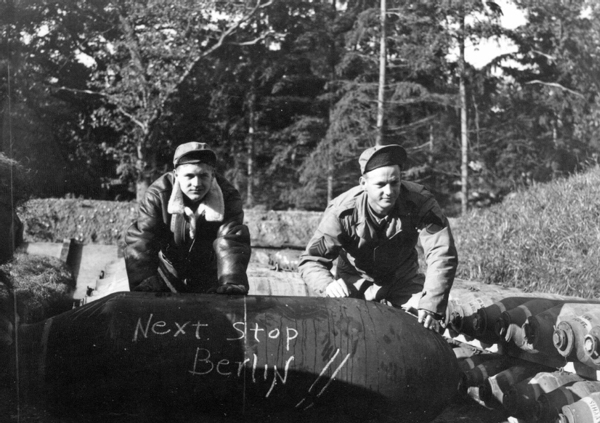
Armorers at work in the bomb dump of an 8AF bomber station in WW2 England.
A small propeller was used to arm the fusing mechanism of the Hale and Carbonit bombs. The tail-mounted propeller would unwind a spindle in the bomb when it was dropped, ultimately letting the striker contact the detonator on impact. The propeller had a guard clip attached to prevent premature arming, and was removed before the bomb was released.
In time, bomb racks and release mechanisms were devised. Next to come along were bomb types with nose-fuses and nose-mounted arming propellers such as the twenty-pound Cooper, which created an instantaneous explosion when the bomb impacted with the ground, scattering deadly fragments over a large area. Made with a light case, this bomb, along with the French flechette dart canister, were among the first anti-personnel bombs to be developed. Tail-fused bombs, on the other hand, had a delayed action, from 1/20th of a second to up to fifteen seconds, and would bury themselves into the ground before exploding. Many bombs of British manufacture were designed to carry two fuses, one in the nose and the other in the tail, as a fail-safe solution to the all-too-common problem of fuse mechanism failure.
Standardization of British bomb types came in near the end of the war, with four basic types then in use. Weights ranged from the old twenty-pound heavy-case Cooper, to the 3,360-pound bomb that was developed to be carried by the Handley-Page V/1500 bomber.
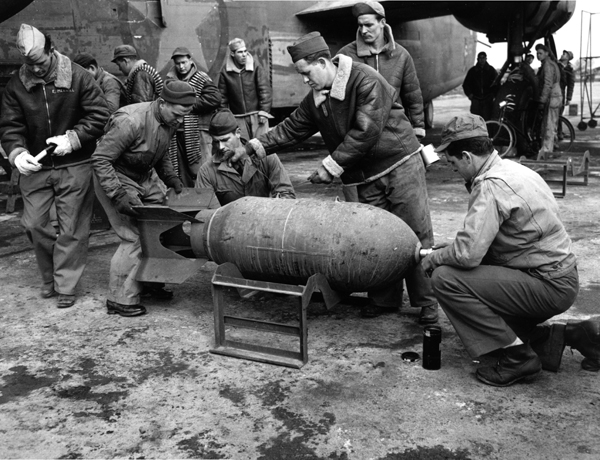
Armorers fusing bombs to be loaded in this Consolidated B-24 Liberator bomber.
Finally, the first true forerunner of the bombs of World War II was the German PuW. It had an aerodynamic torpedo-like shape and a high-grade steel casing, as well as fin design quite similar to that of WWII bombs, which caused the bomb to rotate as it fell, arming the fuses by centrifugal force. The PuW could be carried and dropped from a horizontal position in the bomb racks as well as in internal bomb bays, thus reducing drag and improving the performance of the aircraft.
The incendiary bomb was a concept developed primarily by the Germans during World War I. Earlier British incendiaries utilized a black powder or petrol filler. They were largely ineffective and were replaced late in the war by a phosphorus version. The French were also active in the development of this type of weapon, but it was the Germans who pursued the refinement of the incendiary. Their early efforts were filled with an inflammable mix of kerosene, petrol, and liquid tar, requiring last-minute insertion into the bombs before flight. A later variation using tar, thermite, and benzol produced a 3,000-degree C fire. In 1918 the Germans created an incendiary with a magnesium body that was itself the main burning material. It was intended fundamentally as an anti-personnel weapon.
Throughout the war it was mainly the British and the Germans who made strides in bomber and bomb design and development. They both sought to perfect a combination of long-range heavy bomber aircraft and stable, accurate, and effective bombs capable of generating terror and significant destruction on each other’s cities.
Between World Wars I and II, some highly significant bombers were developed. This was the period when aircraft construction techniques gradually changed from conventional wood and fabric biplanes to stressed-alloy monoplanes. Large bomber types were multi-engined, many of them four-engined for greater safety and reliability.
In the 1930s, the reborn German Air Staff was headed by General Max Wever, a staunch advocate of the strategic bombing concept. Wever planned and was building a sizable strategic bomber force for Germany when, in 1936, he died in an accident and was replaced by General Albert Kesselring, who later was to command the Luftwaffe units in the Battle of Britain and in North Africa. Kesselring favored a purely tactical role for the German bomber, and immediately scrapped Wever’s strategic force program. Had it been allowed to continue to fruition, the course of World War II might have been quite different.
After 1937, the science of bomb development began to escalate. Britain pioneered a new range of weaponry in both armor-piercing and demolition bombs for fragmentation, blast or mining effect, and the RAF concentrated on a new program including an improved class of pyrotechnic devices, flares, flame and smoke floats, as well as aerial mines and combustible magnesium incendiaries. In the early days of World War II, the principal “ordnance” being delivered by the RAF on enemy targets was incendiaries and leaflets. By the end of the first two years of the war, the British were employing more 250-pound and 500-pound general purpose bombs in their strikes that any other bomb types. Their sizes were the most practical for the capabilities of all the then-standard RAF bomber aircraft.
German bombs available at the start of the Second World War ranged from fifty-pound to 1,100-pound types and were similar in fundamentals to those of the British, but a high incidence of failure soon led to the development and implementation of a new and more reliable electrically-fired fuse device. By spring 1940, the Germans were concentrating heavily on their parachute mine designs and it was these weapons which became the mainstay in attacks on British cities. Both the Germans and British went on to design and develop ranges of more sophisticated mines including magnetic, acoustic, and influence types.
There followed the development of the radio-activated proximity fuse which allowed a bomb to be detonated at a prescribed altitude above the ground. The RAF then began experimenting with the so-called “light-case” concept in bomb design. Having discovered in practice during the first year of World War II that streamlining the shape and design characteristics of its bombs in order to minimize drag and prevent tumbling was, in fact, unnecessary, British scientists went to work on a new type of bomb. It was to be a 4,000-pounder containing an explosive compound called RDX which offered both ease of manufacture and relative safety in handling it. The new LC bomb was actually a welded drum of thin gauge steel and the empty casing was filled with the molten RDX material. The highly powerful blast bomb that resulted was known by the Allies as the “blockbuster” and by the crews of RAF Bomber Command as the “cookie.”
There was no more efficient and effective heavy bomber in World War II than the Avro Lancaster with its unobstucted bomb bay and its impressive load-carrying capability. As early as 1942 RAF Bomber Command was using its Lancasters to deliver both the 4,000-pound cookies and an 8,000-pound version of the same bomb, which was really two cookies bolted together for twice the effect. The immense bomb bay of the Lanc could accommodate even greater weapons, such as the triple-cookie unit known as the “tallboy,” for use against special targets such as the 42,000-ton German battleship Tirpitz. The Tirpitz was sunk by Tallboy bombs of 617 Squadron off Tromso Harbor in northern Norway on 12 November 1944, with the loss of more than 1,400 German crew. The British had been determined to sink the Tirpitz since her commissioning in 1941 and had pursued her doggedly. The development of the Tallboy provided the RAF with the means for eliminating the great German warship.
To meet a requirement for a bomb of even more destructive force than Tallboy, the RAF turned to the innovative Vickers Aircraft Chief Engineer and designer Barnes Wallis, whose geodesic construction approach for the Wellington bomber had contributed hugely to the effectiveness of that aircraft. Wallis had also been asked to design a bomb for use by a new special-task squadron, No 617, against the Mohne, Eder, and Sorpe dams of Germany’s industrial Ruhr Valley. His solution to the problem of how to breach these enormous structures came in the form of a large, drum-shaped device to be carried partially extended from the bomb bay of the Lancaster. Before release, the “dam buster” bomb was made to rotate on its mount at a high rate of speed by an motor within the fuselage of the Lanc. Wallis calculated that, to function properly, the spinning bomb must be released at a height of exactly sixty feet above the water of the reservoir behind such a dam. In theory, the spinning device would then bounce along the surface of the water to contact the wall of the dam and then sink towards the bottom and be detonated at a precise depth by a hydrostatic fuse. After much rehearsal it was felt that the squadron and the weapon, now called Upkeep, were ready, and the raid was carried out on the night of 16-17 May 1943 by a small force of bombers which managed to reach the target area and breach two of the three dams. Wing Commander Guy Gibson led the attack and for his effort was awarded the Victoria Cross, Britain’s highest military distinction. Later in the war, Gibson was killed while flying as a Pathfinder for bombers attacking the Ruhr.
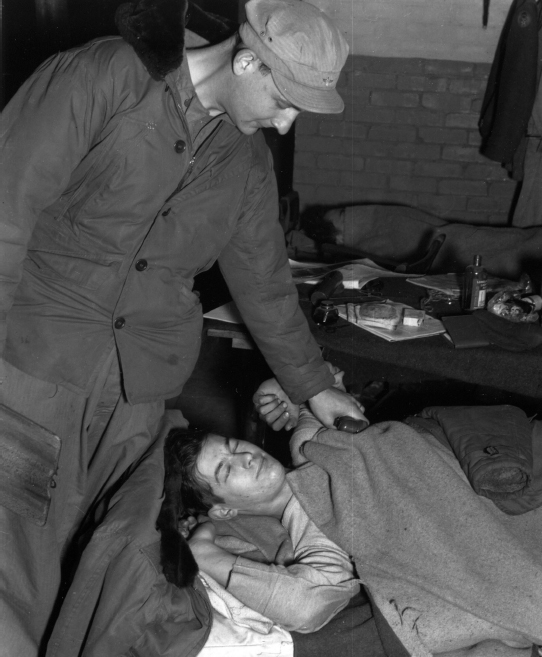
An early wake-up call for this 8AF bomber crewman. HIs breakfast was followed by a thorough briefing for the day’s mission to Germany.
Now Wallis was asked to find a way of damaging targets such as the seemingly impenetrable German submarine pens along the Biscay coast of France. These massive reinforced concrete structures, with walls and roofs many feet thick, had proven utterly bomb-resistant in attacks by both the RAF and the American Eighth Air Force. In fact, the RAF’s Sir Arthur “Bomber” Harris believed that the effort expended attacking the sub pens was futile and that his force was better utilized in attacks on the shipyards where the U-boats were being built. Harris targeted the submarine construction facilities with considerable effect even though he felt that the requirement for such attacks diverted his force from its primary assignment, the all-out assault on German cities.
Life in a Nissen hut;.
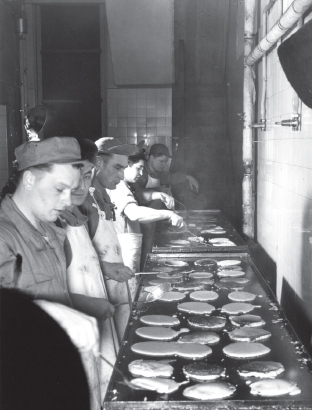
Pancakes for the customers of the combat mess;

American bombs for delivery to German targets in occupied Europe.
Target selection at 8AF HQ, Pinetree, High Wycombe;
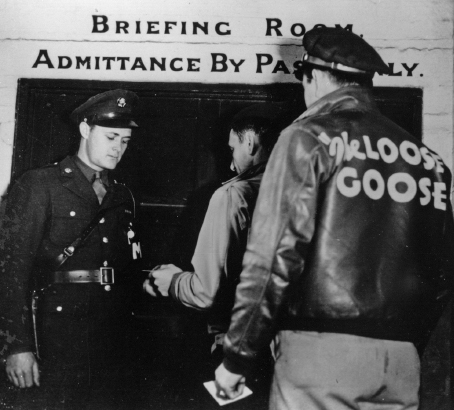
Entering the briefing for a mission;
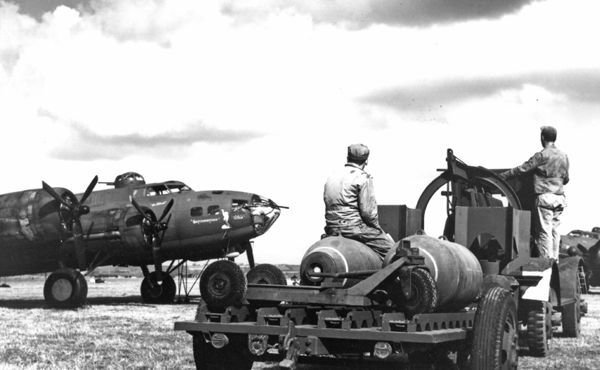
Delivering bombs to a B-17 Flying Fortress somewhere in England.
An 8AF armorer attends to fuse warning tags on the bombs in his aircraft before a mission;
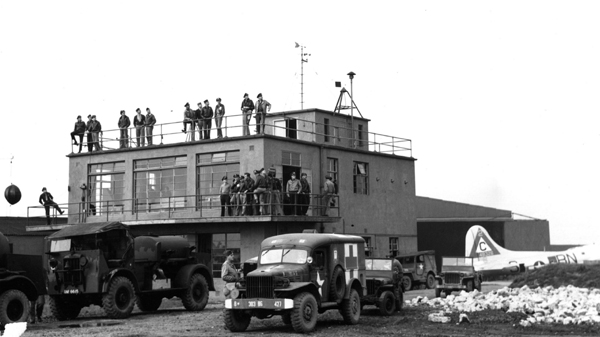
The Flying Control tower at Molesworth, home of the 303rd Bomb Gourp, Eighth Air Force.
Wallis, meanwhile, thought that a possible solution for attacking the sub pens lay in a notion he had for what he called an “earthquake” bomb. It was to be a conventional high explosive device, but with a weight of 22,000 pounds. Streamlined, the bomb had canted tail fins to make it spin as it fell, and was made with a heavy case. Wallis intended that the bomb be dropped against great, solid structures like the pens. He expected it to go deep underground on impact and then be detonated, causing an earth tremor that would literally shake down the target structure. It worked well when employed against a target such as the enormous railway viaduct at Bielefeld, but as visitors to France’s Brittany coast will see, the great sub pens of Brest, Saint Nazaire, Lorient, La Pallice and Bordeaux remain today, largely, unaffected by all Allied attempts to destroy them.
Other bombing weapons and techniques resulting from this wartime development period included the Royal Navy Disney rocket bomb, a 4,500-pound hard-case bomb with a rocket in the tail, though to be useful against hardened targets like the sub pens. The rocket was ignited by a barometric fuse after the weapon had fallen freely from release altitude to 5,000 feet. The rocket accelerated the bomb to a velocity of 2,400 feet a second. The U.S. Eighth Air Force made limited use of the bomb in the spring of 1945 with arguable results. Another development of the time was the fire weapon, Napalm, a jellied petroleum mixture taking its name from the combination of naptha and palm oil. The mix was carried mainly in 108-gallon U.S. fighter fuel drop tanks with small igniter units. The Napalm “bombs” were first used against German strong points on the French coast in 1945.
Yet another amazing bombing technique was the Aphrodite Project, in which an American bomber, usually a war-weary B-17, was completely filled with the high explosive Torpex, 20,000 pounds of it, and was flown to a point on the English coast. There the pilot baled out and the aircraft continued to its target under radio direction guidance from a ground station. The intended targets were the German V-weapon sites in the Pas de Calais. One such sortie cost the life of the pilot, U.S. Navy Lieutenant Joseph Kennedy, Jr., son of the former U.S. Ambassador to Britain and elder brother of the post-war President John F. Kennedy. Kennedy, and another crewman were killed when their B-24 Liberator drone prematurely exploded near Blythburgh, Suffolk, on 12 August 1944. A similar radio-guided “aircraft drone bomb” program of the Germans called Mistel involved a variety of fighter and bomber combinations in which the fighter was mounted on top of the bomber, which was guided toward its target by the fighter pilot who then released the “bomber-bomb” which was supposed to continue to its target under radio-control. The effect of this effort was minimal.
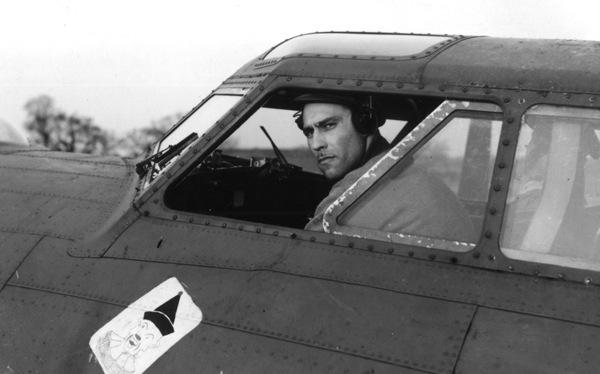
Richard E. Bynum, pilot of this 388th Bomb Group B-17 at Knettishall.
Probably nothing contributed more to the success of the Eighth and other American air forces’ bombers than the Norden bombsight. As famous as the Andrews Sisters, Lucky Strike Green, and Kilroy, the ultra-secret Norden was the standard high and medium-altitude bomb sight of the U.S. bomber forces throughout the war. The device was, for the time, quite sophisticated. Its development was begun in 1928 by the Dutch-born inventor Carl L. Norden. Utilizing ground speed, drift, trail, and bomb ballistics information fed into it by the bombardier, the instrument was able to compute a precise release point for the bomb load. The bombardier used a telescopic element on the Norden unit to establish and compensate for deflection and synchronize the sight. For the final moments of the bomb run, he “flew” the airplane through the Automatic Flight Control Equipment (AFCE) of the sight package, which was linked to the autopilot of the bomber. Thus he was able to make flight adjustments through the marvelous bombsight. It was the accuracy of the Norden sight that, in large part, gave the Americans confidence to persist with their daylight bombing philosophy in World War II.
The other principal aid to bombing accuracy in that war was radar. A range of radio navigation and radar systems was developed and deployed to bring improvements in accuracy of placement and in target marking by the Pathfinder aircraft. The British H2S and Oboe systems were key elements in the bombing campaigns of Bomber Command. The H2S was a radar set mounted in RAF bombers which provided a terrain image that enabled the aircraft to bomb more effectively at night and through heavy cloud cover. It was used for the first time in RAF attacks on Hamburg in July 1943. The Oboe system was a means by which the British bombers could be directed to their targets at night through the use of two radio beams being transmitted from England. The beams intersected over the bomber’s target and the aircraft’s pilot simply flew along one beam until he crossed the other beam, indicating he had reached the bomb release point over his target.
With the final weeks of the war came the advent of the most significant and terrifying weapon yet devised. The bombs called atomic were the products of scientists of many nations and many disciplines. The story of these weapons is told in another chapter of this book, and it is perhaps enough to note now that the concept behind the first atom bombs revolved around a staggering release of energy which caused the surrounding air to be heated to an extremely high temperature, coupled with the emmission of high levels of radiation on a variety of wave lengths.
The first two atom bombs were known by their makers as Fat Man and Little Boy. Little Boy, the weapon delivered over Hiroshima, Japan, on 6 August 1945 by the B-29 Enola Gay, which was piloted by Colonel Paul W. Tibbets, was a “gun-type” device. Within its casing lay a shaped element of Uranium U-235 which, when the bomb reached detonation altitude over its target, was “fired” into another U-235 shape, resulting in a nuclear explosion. The blast, heat, and radiation release of Little Boy killed more than 80,000 people in Hiroshima. The second atom bomb, Fat Man, killed 40,000 more Japanese at Nagasaki three days after the Hiroshima raid. The immensely powerful and destructive weapons which helped to bring World War II to an end were but relative firecrackers when compared to the force and fury of the nuclear and thermonuclear weapons to follow in the post-war years. Ultimately, several nations were to join the nuclear club, and the world arms race was on in earnest.
In the years since the end of that war, the world’s nuclear arsenals have grown to the point where the estimated casualties in a major nuclear confrontation range from a few hundred million to upwards of 25 percent of the earth’s population. The United States alone is believed to have the nuclear capability to obliterate all human life several times over. But in the time since the end of the war, the United States and other world powers have continued the development of conventional bomb-type weapons and have produced them in the hundreds of millions. They range from demolition and high explosive to incendiary, fire and chemical types, to depth charges and aerial mines, fragmentation, cluster, unguided aerial rockets and laser-guided “smart” bombs. In the Gulf War, the range of Paveway laser-guided bombs included high and low speed, penetrator and glide bomb types in 500-, 1,000-, and 2,000-pound weights. In the precision-guided bombing system a target designator-supplied infra-red or daylight image appears on a screen in the attacking aircraft cockpit. The pilot or the weapons systems officer then aligns the cross hairs on the target impact point and locks the impact point into the system. Now the infra-red sensor and its laser stay locked on the target IP. The laser-guided bomb or bombs are released in the vicinity of the target and, just seconds before impact, a pre-coded energy beam is fired by the designator at the targeting impact point. A seeker in the nose of the weapon picks up reflected laser energy which aims the missile at the precise impact point, “flying it” by means of movable fins on the weapon.
The Norden bombsight used in the bombers of the 8AF in WW2 combined an analog computer and linkage to the airplane’s autopilot, and was extremely accurate.
The B-24 Liberator bomber Exterminator of the 330th Bomb Squadron, 93rd Bomb Group, 8AF, based at Hardwick, England.
Typically in the Gulf, four RAF Tornado bombers utilized three 1,000-pound British LGBs each in a successful attack on an Iraqi bridge, whereas destroying a hardened aircraft shelter usually required only a single aircraft carrying two of the smart weapons. Tornado GR.Mk 1s flew more than 1,600 sorties in the Gulf War, dropping more than 4,200 conventional free-fall bombs and more than 950 LGBs, Coalition aircraft using mainly LGBs destroyed approximately 350 of Iraq’s 594 hardened aircraft shelters in the war. Additional airfield targets included fuel and ammunition storage facilities, command bunkers and runways. F-117A stealth fighter/bombers starred in their ultra-precise delivery of laser-guided weapons on Iraqi command and control facilities, bridges and other difficult targets, many in Baghdad itself.
In the late 1970s one estimate of the combined destructive power of just the conventional bombs arsenal of the United States at that time was a capability to destroy 10 percent of the Earth’s inhabitable surface and up to 35 percent of its population. Weapons development continues world-wide at a pace at least as frenetic as that of the debate over the ethics and effectivity of bombing. The characteristics of the weapons are limited only by the imaginations of the designers and those who cause them to be developed. Aerial bombardment has been with us through most of the twentieth century and the concept and practice continues in its many forms into the new century.
Ground personnel and other airmen of this American heavy bomber group awaiting the return of their airplanes from the day’s mission. This was referred to as “sweating them in.”
In 1999 Lieutenant Commander Horace Taylor died. He was 90 and had won the George Cross for his actions as a wartime bomb and mine disposal expert in Britain. In his preparations before dealing with a weapon, Taylor always dug what he called a “funk hole,” “not very deep, but fairly wide, as I should be coming over the top at some speed. My colleagues used to think that my funk holes were too close to the job, but I reckoned they were better too close than just out of reach.” In one incident “a bomb went off on me as I was working and blew me right through two houses. I came down four streets away. When the thing exploded I forgot to lose consciousness. I was so excited. I knew exactly what had gone wrong, and all I wanted to do was to tell my boss what had happened for the sake of the rest of the crew.” All of Taylor’s clothes had been blown off by the explosion and he had been temporarily blinded by the dust, but he managed to telephone his superior before being taken to hospital at Leamington Spa . . . in a ladies ward.